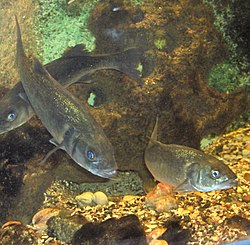Pair trawling

Pair trawling is a fishing activity carried out by two boats, with one towing each warp (the towing cables). As the mouth of the net is kept open by the lateral pull of the individual vessels, otter boards are not required. With the towing power of two boats and no otter boards, a larger net may be worked than would otherwise be possible, or alternatively, the two boats can share increased fuel efficiency.[1]
As doors are not necessary, the gear arrangements are simplified, with the warps attaching directly to the wings of the net. Setting and hauling of the nets are carried out by one boat, while the other is only used for towing; usually each will take turns at these operations.[2]
Pair trawling is effective on all
Because of the increased efficiency of pair trawling, vessels are able to tow their gears in mid-water at a faster speed to target species which are normally able to escape trawl nets, such as the
References
- ISBN 0-85238-217-0
- ^ The South-west Territorial Waters (Prohibition of Pair Trawling) (Amendment) Order 2005 "Defra, UK - Fisheries - Sea fisheries - Conservation - Bass pair-trawl fishery". Archived from the original on 2007-02-06. Retrieved 2007-04-10.
- Thomson, David: Pair trawling and pair seining. The technology of two-boat fishing. Farnham: Fishing News Books, 1978


